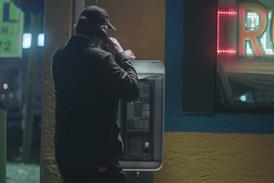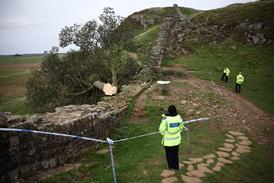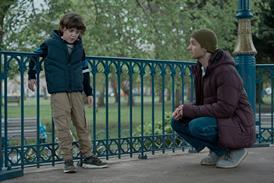With ever-growing demands for high-quality and high-definition footage, the pressure is on to ‘up-res’ mountains of archive material. Andy Stout looks at technology improving the past.
Given the sheer volume of material involved, it’s hardly surprising that figures for the amount of archive material held by broadcasters around the world are unreliable. The top-end estimates put the size of European vaults alone at around 50 million hours. Even if only 1% of that is of interest, it still represents nearly 60 solid years of programming. Monetising that content is becoming steadily more problematic as high definition is established – a growing frustration for rights holders and programme-makers.
“A few years ago, a documentary destined for the international market was only allowed to have 30% of its footage as SD,” says Paul Gardner, head of archive at Darlow Smithson. “Now that’s dropped to 10%. Making historical programmes with only 10% SD is very difficult.”
Gardner won Researcher of the Year at the recent Focal International Awards 2009 for The Thriller in Manila, a sports doc made in 2008 about the 1975 Muhammad Ali versus Joe Frazier fight in the Philippines.
“That had 50 minutes of SD archive in a 100 minute programme, and you couldn’t make it under those rules today,” he says.
Many film-based libraries can supply footage in HD, simply telecineing film to HDCAM, for example, rather than digital (or outsourcing the work to facility houses). But there is a mark-up involved, which is currently hovering around the 40% mark. Stock footage is similarly more expensive, and royalties can be 10-40% higher. This can put an extra strain on hard-pressed budgets, though there are workarounds.
To meet the HD quota for National Geographic’s Generals at War, which featured archive footage from WWII, Windfall Films company director Ian Duncan recalls filming a scene in HD where two generals were watching archive SD footage on a screen. And, of course, more and more material is being made available at higher resolutions as archives digitise and move their catalogues online. The Imperial War Museum archive, for instance, is looking to establish in-house scanning facilities and digitise its blue-chip material at 2K, while around 10% of the BBC Motion Gallery’s online catalogue is now HD (though the 100,000 clips are only around 1% of the complete archive).
Increased demand
Even the static-image libraries are having to work at higher resolutions, ideally using drum scanners that have a greater colour gamut than their flatbed cousins. “There’s a definite increase in demand [for higher resolutions],” says Gareth Clayton, account manager at fine art specialist archive Bridgeman. “I have been sending out uncompressed hi-res TIFF files to the BBC because it requires hi-res files for its hi-def programming.”
Until the archives are digitised though, up-resing and restoring archive material for HD represents a valuable revenue stream for facilities, especially as the investment costs are comparatively minimal for those that have already equipped to enter the Digital Intermediate space. “Everything shot on film today goes through some element of restoration, so we have the tools already,” explains Ascent Media chief technical officer Adrian Bull. “One of the final elements of the DI process, for instance, is to take out neg sparkle [white spots caused by dirt or minute scratches on the negative].”
The tools developed for DI and restoration have become progressively more sophisticated over the years, to the extent that Bull estimates that 30–40% of the job can be done in realtime using automated processes that deal with sparkles, stabilisation, minor scratches and tears (incidentally, this makes compression much more straightforward as the codecs don’t have to deal with extraneous artefacts). The rest though, including serious tear repair, tramlines, hair removal and so on, is a labour-intensive, manual on-screen process. Costs vary wildly depending on what is actually required, and sometimes it can be more cost-effective to work on the physical film first before scanning it for digital processing. At the top end, budgets for remastering and restoring a feature can be £30,000, with £15,000 to £20,000 typical.
There is a lot of work going on too. Bull estimates around 10% of Ascent’s turnover comes from restoration work, such as an ongoing contract with the BFI under which 40-50 titles are being restored each year. And while they may be coy about it, Broadcast understands that across Soho, several major broadcasters are quietly repurposing tens of hours per week of their archive for future HD transmission.
For broadcasters looking to make the most out of their archive, there is also the promise of a release onto Blu-ray. The latest figures suggest that in Western Europe, Blu-ray will only have 35% of the market by 2012. But while sales might still be comparatively low in relation to DVD, just over 3.5m discs were sold in the UK in 2008 – a 400% increase on 2007.
“We’re getting a lot of interest from all sides in Blu-ray; it’s really gone through the roof,” says James Greenwall, sales manager at Dubbs and Eyeframe, which is planning to install a third Blu-ray authoring suite soon. “People held off while the format war with HD DVD was underway, but now that’s over, they’re interested and you just can’t use the same old tapes for it as you did with DVD.”
Scanning options
It’s a potentially lucrative market, but quality is the key, which by necessity means rescanning the neg. Scanning at HD 4:2:2 is often considered more than acceptable, although for additional future proofing, 2K is probably the ideal route. If the budget exists, the results of that alone can be dramatic. Vince Narduzzo of Narduzzo Too graded both the original The Lost Prince in 2002 and last year’s Blu-ray re-release from joint BBC Worldwide/VCI venture 2 Entertain Video. “Just the fact you’re scanning the material at 2K changes everything,” he says. “It’s like taking a stocking off the lens.”
For all its nascent potential, at the moment the fact remains that the increasingly HD present is still heavily reliant on the SD past. “That’s not just a researcher’s problem either, it’s a commissioning one as well,” concludes Gardner.
Restoring Pride
The recent Blu-ray release of Andrew Davies’ 1995 adaptation of Pride and Prejudice from 2 Ent-ertain illustrates exactly what can be achieved, even with quite recent material. “It took almost a year from start to finish, but the result is both deeper and richer,” says 2 Entertain head of production Lesley Johnson.
Originally filmed on super 16, the project was rescanned at 2K on the Spirit and then graded on Nucoda Film Master by Vince Narduzzo at Narduzzo Too in Pinewood. Once rescanned, the grade is a fairly normal process, taking somewhere between two or three days per episode. One further pass is then made to clean up the images, with several processes such as despotting set up automatically overnight.
“We were able to pick out tons more detail in the blacks. It really was quite incredible,” says Narduzzo. “We might have added a vignette layer to pull in the sides and add to the atmosphere here and there, but we were always careful to be restrained. With this type of material, ideally you want the grade to be as unnoticeable as possible and let the drama stand on its own.”
Tools of the Restoration Trade
Many of the tools used in the restoration process, such as Mokey and PF Clean, were software tools originally developed for visual effects work. They analyse consecutive frames in a sequence, and can work out what should be in the image and what is an undesired artefact. They can even replace areas hidden under artefacts with the appropriate background, from several frames away in the sequence.
Multifunction powerhouses such as MTI Correct or Nucoda Phoenix can tackle a whole host of issues automatically, as well as the serious problems that require a human operator to work on frame by frame.
Many of the DI grading systems from leading developers such as Quantel, Autodesk and Avid also contain toolsets that can tackle restoring archive material.
As for digitally ‘up-resing’ SD material to HD in post for release on Blu-ray, the technology has yet to impress. “A Blu-ray player will automatically up-res a DVD to play in HD,” says 2 Entertain head of production Lesley Johnson.
“I’ve compared that with material that’s been up-resed from digi in post and then encoded for Blu-ray, and I don’t think there’s enough difference to make it worthwhile.”

























No comments yet